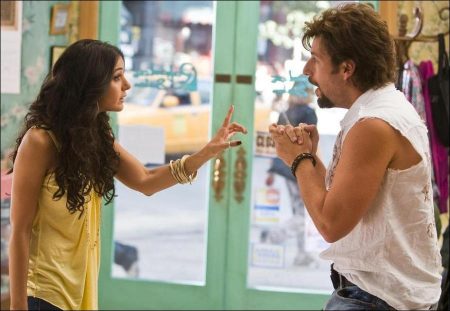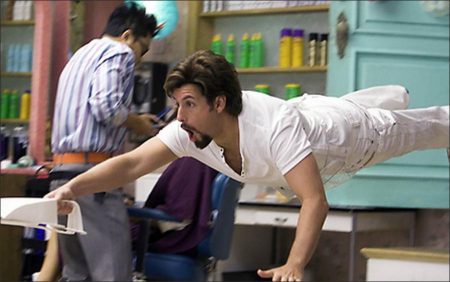Bringing Israelis and Arabs Together
You Don’t Mess with the Zohan Movie Trailer. A movie about an Israeli soldier and a Palestinian terrorist coming together? It’s not as crazy as it sounds, says director Dennis Dugan. “The people living in conflict in the Middle East are the same people living in one neighborhood in New York – except that while there may be rivalries in Gaza, they don’t hate each other in Brooklyn. Everybody just gets along,” he notes. “They treat each other more as people than as rival factions. You Don’t Mess with the Zohan is a comedic way of sort of getting at the West Side Story aspect of life.”
Amazingly enough, Smigel notes, the story of the movie was reflected on the set. “One of the great things on the set – and we didn’t do this intentionally – was that we had many scenes that involved all the Arab guys and the Israeli guys in the same scene, meaning they were all called to the set together,” says Smigel. “Everyone would be eating lunch together. They had a lot of passionate discussions, but it was very friendly, very healthy, very open-minded. It was really cool to see – some of the guys have said to me that it’s the most they’ve every talked to an Arab or an Israeli before.”
One key to bringing You Don’t Mess with the Zohan to the screen was to hire the best and funniest actors from Israel and the Arab world to bring to life the supporting roles. “We have an entire squad of people – not just the usual suspects from Happy Madison,” says Dugan. “We went from Israel to Palestine to New York to Anaheim, all over Los Angeles, to find people from the Middle East – Israelis and Arabs alike – to be in the movie. I think we read every SAG and non-SAG acting aspirant for this movie. With 175 roles in the movie, we had to do that.”
“Toward the end of the shoot, I heard from some of the actors that they’d grown up hating or mistrusting all Israelis or all Arabs – until they came here,” Smigel adds. “They actually said the shoot was a life-altering experience. Even though we make the point in the movie, I think it was a shock to everyone to see how much they all had in common. Look, it’s not like we think we’re solving anything with this film; we just wanted to be funny. But even for me, as a Jew, it was very interesting to feel as close to the Arabs on the set as I did to the Israelis.”
To play Oori, who becomes Zohan’s guide to all things American, the filmmakers found Ido Mosseri, who has been an actor in his native Israel since he was eight years old. “I’ve always dreamt about Hollywood, but it was something I didn’t think would really happen. Being in an American movie with Adam Sandler is more than a dream for me.”
“It was a great acting school for me to watch Adam work,” he says. “He’s so kind and giving, and he’s a very fun man to be with – he’s like a child sometimes. It’s important to love what you do and I can see all the time how Adam loves his work – and how he enjoys it and how much he wants everyone else to feel the same way.”
“I’m always happy for the opportunity to work with Arab actors,” Mosseri adds. “On the Zohan set, I think the first time the Arab and the Israeli actors met each other, I think we immediately became friends – we have a lot in common. Each of us comes from his own place and his own opinions and his own background. The most important thing that we were sitting together and listening to each other and wanting to learn about the other. So I felt privileged that we had the opportunity to play together, to talk together, to get to know each other. We became real friends.”
About Mosseri, Smigel says, “When I was writing the Israeli characters as horndogs, I worried if it was too much of a stereotype. Fortunately, Ido fulfilled all my dreams. At one point on the set he was raving about Tel Aviv, the scene there, and how I had to visit. Then he paused and asked me if I was married, and I said yes. He said, ‘Well… maybe you don’t need.”
About the Production
You Don’t Mess with the Zohan reunites many key production personnel. The film marks production designer Perry Andelin Blake’s tenth Happy Madison production and costume designer Ellen Lutter’s ninth film with the team. Editor Tom Costain previously served as assistant editor of many Sandler productions. Cinematographer Michael Barrett joins the team for the first time.
Blake says that all departments, as well as input from Dugan and Sandler, are key to determining the look of the film. “Dennis Dugan and Adam Sandler are heavily involved. As we do some photo shops – playing with design for specific locations – we also work with Ellen to share pictures of the locations and the colors we’re going to use. She’s always done a ton of research – on Zohan, she showed us the uniforms for the Israeli army and the clothes an average Palestinian might wear. We take from her the colors that she feels are right, and we coalesce everything into one design concept.”
Although most of the film was shot in New York and Los Angeles, Dugan and a small crew shot a few scenes on a Tel Aviv beach. “The beginning of the movie takes place in Tel Aviv in the summer, so I went there and worked with an all-Israeli crew and got some shots of the very crowded beach in Tel Aviv. For some other shots from the same scene, we filmed on a beach in Mexico. In Israel, there is a very distinctive orange umbrella that is put out by an ice cream company – those umbrellas are all over the beach. We got those umbrellas and shipped about a hundred or so down to Mexico.”
One part of production that was unusual for a Happy Madison production were the many, many stunts required to bring the world’s greatest Israeli counter-terrorist to the screen. “Just like a Bourne or Spider-Man, where we play the stunts straight, we played them pretty straight in Zohan,” says Rogers. “We tried to give Sandler a foundation he could leap from: his Zohan is stronger, faster, and more capable than any human being, but he’s not a superhero.”
Rogers admits that that part – pushing Zohan just beyond the boundaries of human possibility – was the best part. “We played him 10 percent beyond what a human could actually do,” he says. “It gave us the freedom to make him bigger than life and to get real creative. The swimming scene where he swims down the Phantom, who’s on a jet ski, was just an extraordinary opportunity to do some pretty fun stuff. We play it straight, but then you know in the context of what’s going on, it’s a very funny stunt and a very funny scene.
“When we first were talking about the scene, I pitched that he would swim like a dolphin,” he continues. “They loved it, but were skeptical that we could pull it off. We had to find the right boat and the right equipment, and then, we went to the swim facility at USC and found the right swimmer, Meir Hasbani, a guy on the Israeli national team, believe it or not. We cruised along the water at 18 miles per hour, flying him on wires, and then we started porpoising him through the water. It actually came together fairly easily.” So easily, in fact, that Sandler wasn’t about to let the opportunity slip by without trying the rig himself – and soon the star was swimming like a dolphin through the blue sea of La Paz.
“Of course Zohan can do anything – he isn’t limited to running fast or martial arts or swimming; he does everything,” Rogers notes. “Whatever the circumstance demanded, we looked for the best possible person for that specific talent. We brought in free runners to jump from building to building. We had gymnasts to do some of the floor routines on the chair. We had dancers for the disco scenes and we had the swimmers for the water scenes. Those were just some of the stunt people. I’ve never heard of anybody having this many doubles for one character; it’s almost ridiculous, but at the same time, it’s very funny.”
You Don’t Mess with the Zohan (2008)
Directed by: Dennis Dugan
Starring: Adam Sandler, Alex Luria, Emmanuelle Chriqui, Lainie Kazan, Rob Schneider, Sayed Badreya, Shelley Berman, Mariah Carey, Charlotte Rae, Nick Swardson, Dina Doron
Screenplay by: Adam Sandler, Judd Apatow, Robert Smigel
Production Design by: Perry Andelin Blake
Cihematography by: Michael Barrett
Film Editing by: Tom Costain
Costume Design by: Ellen Lutter
Set Decoration by: Ronald R. Reiss
Art Direction by: Alan Au, John Collins
Music by: Rupert Gregson-Williams
MPAA Rating: PG-13 for crude and sexual content, language, nudity.
Distributed by: Columbia Pictures
Release Date: June 6, 2008
Views: 229






